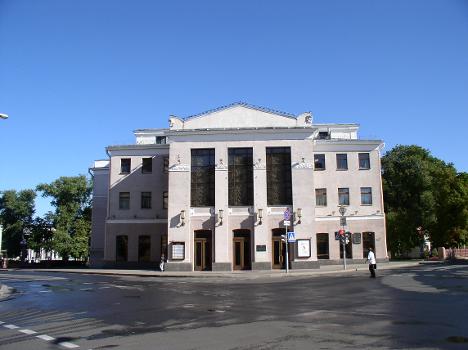General Information
| Completion: | 1920 |
|---|---|
| Status: | in use |
Project Type
| Function / usage: |
Theater building |
|---|
Location
Technical Information
There currently is no technical data available.
Excerpt from Wikipedia
Janka Kupała National Theatre (Belarusian: Нацыянальны акадэмічны тэатр імя Янкі Купалы, Minsk) is the oldest existing theatre of Belarus. Also, the theatre is an object of cultural heritage of Belarus.
Initial construction
The building of the theatre was built in 1890 by the project of architects Kostantin Vvedensky and Karol Kozlowski. The construction was financed from donations of the citizens of Minsk.
The main facade looks out onto the square formed by the intersection of two central streets, vulica Karla Marksa and vulica Frydrycha Enhielsa.
History
The modern theatre was established on September 14, 1920, and it is located in a building of the Minsk provincial theatre. In 1944 has been renamed in honour of classic of the Belarusian literature, poet Janka Kupała.
The building has been the venue of several important historical congresses in the first half of the 20th century.
On 2-8 December 1917, the First Congress of the Armies of the Russian Western Front took place in the theatre building, which was attended by 714 delegates, including 473 Bolsheviks. Vladimir Lenin was elected honorary chairman. Representatives of the central Bolshevik structures Sergo Ordzhonikidze and V. Volodarsky took part in the congress. The congress declared the recognition of Bolshevik rule in Russia, elected a new command of the Western Front, in which the Bolsheviks took the dominant positions.
On December 18-31, 1917, the theatre hosted the First All-Belarusian Congress, a representative national congress of Belarusians. The event brought together almost 1,900 delegates from all regions of Belarus to discuss the future political status of Belarus and ist system of government. The congress was forcibly dispersed by the Russian Bolsheviks, under whose control Minsk was at the time. The Council formed at the congress continued to operate underground, in February-March 1918 it announced the creation of an independent Belarusian Democratic Republic and still exists today as the Rada BNR.
On 2-3 February 1919, the Bolshevik Provisional Government of the Soviet Socialist Republic of Belarus held the First All-Belarusian Congress of Soviets of Workers', Soldiers' and Red Army Deputies in the theatre building, at which 230 delegates from various Bolshevik structures approved the first constitution of Soviet Belarus. They passed resolutions to declare a federation of Soviet Belarus and Soviet Russia, ceded significant territories of Belarus to Russia.
On 27 June 1944, during the Nazi occupation of Belarus, the theatre hosted the Second All-Belarusian Congress convened by Belarusian political forces united around the collaborationist Belarusian Central Rada. The congress brought together 1,039 delegates representing various regions of Belarus, including Bielastok and Smalensk, and organisations of the Belarusian diaspora. The congress adopted resolutions condemning Soviet and Polish policies toward Belarus, reaffirming Belarus' status as an independent state, and declaring the Belarusian Central Rada as the temporary supreme Belarusian state body.
Text imported from Wikipedia article "Janka Kupala National Theatre" and modified on June 2, 2020 according to the CC-BY-SA 4.0 International license.
Participants
Currently there is no information available about persons or companies having participated in this project.
Relevant Web Sites
- About this
data sheet - Structure-ID
20034020 - Published on:
10/01/2008 - Last updated on:
16/05/2015





